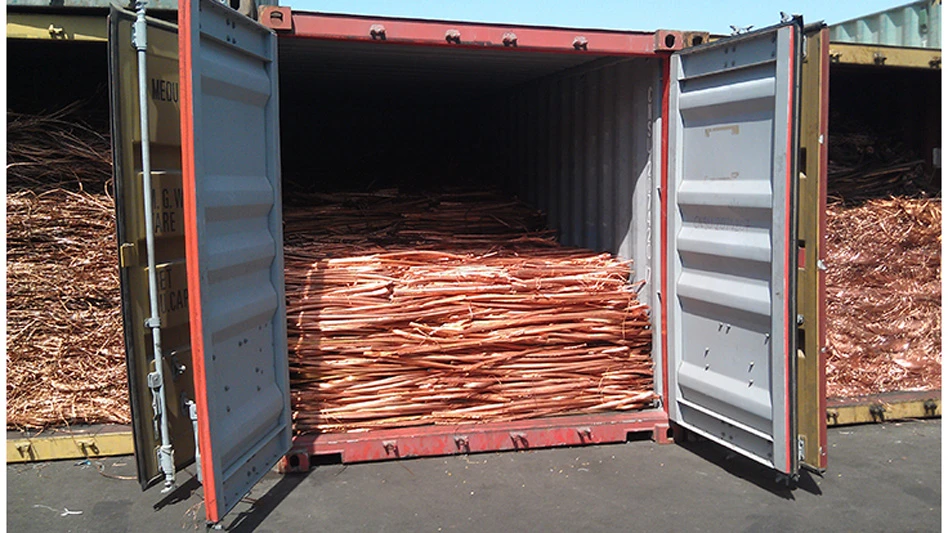Converted scrap handlers are excavators that have been modified to better perform in the yard. As mentioned in the feature "Buying A Scrap Handler," an excavator’s curved banana-style boom is straightened and lengthened. Other modifications can also be made to the front’s hoist cylinders to beef them up. In addition, the excavator’s undercarriage is normally widened to provide an enhanced lifting capability similar to that of a purpose-built handler.
There are also several other modifications that have to be made to the excavator, including adding additional counterweight and cab risers. Modifications can also be made to convert excavators to railcranes and to electric-powered stationary scrap handlers.
COUNTERWEIGHTS
An important feature of a scrap handler conversion is the addition of counterweight. This addition will increase the overall lift capacity. However, it is important that the machine you are looking at has not had too much additional counterweight added. Each original equipment manufacturer has guidelines for adding counterweight. Most require the addition of frame reinforcement. If more counterweight has been added than the factory allows, and if no frame reinforcement has been installed, the machine can experience premature bearing failure or frame fatigue.
Always check with the manufacturer to find out the maximum allowable counterweight. Counterweight can be added in several forms, including additional fill to the standard counterweight, slabs of steel welded to the top of existing counterweight, and slabs of steel sandwiched between the existing counterweight and the frame of the machine.
CAB RISERS
Other features of machine conversions include the addition of cab risers to allow operators to better see into trucks and gondola cars. Most machines offer two varieties of cab risers. One is a 4- foot riser with a ladder up the side; the other is a 6-foot riser with a platform, ladder and railing system. Most risers are manually tiltable for transport. It is advisable that the cab riser have a safety window guard to protect the operator from large pieces of material that may come back into the window. The riser should meet safety codes that require it to have minimum distances between steps, adequate grab handles located in such a way to allow operators to have a three point stance and a kick plate around the edge of the platform to prevent a mechanic from kicking off a tool and injuring a co-worker.
The American Society of Mechanical Engineers, Fairfield, N.J., is currently in the process of writing the safety volume (B30.25), Scrap and Material Handlers, that will include the items above. The Institute of Scrap Recycling Industries, Washington, and standard writing bodies such as ASME have done a good job in making the public aware of safety issues. When purchasing a material handler, consideration should be given to safety issues that will minimize injury to workers.
RAIL CRANES
In addition to the standard track scrap handling conversions, there are rail-mounted material handlers and electrically operated machines. Rail-mounted hydraulic scrap handlers are fast becoming the machine of choice for new electric arc minimills and large scrap yards. Having the benefits of the faster, newer hydraulic material handler upper, while still being able to operate on rail, is a real advantage.
When looking at a rail-mounted conversion, it is important to understand what is involved in the refurbishment of a rail lower. You want to verify that the main frame of the lower has been fully inspected and that all cracks have been repaired. Also, it is important that the rail unit has not had excessive ballast or counterweight added in an attempt to get acceptable over-the-side lift capacity. This additional weight can lead to frame fatigue and possible axle failures.
It is important to have the proper size rail lower match the size of the hydraulic material handling upper. To alleviate these concerns, units can now be purchased using newly manufactured rail lowers. The benefits of buying a new unit include having a factory warranty, original manufacturer’s spare parts and reliable lift charts.
ELECTRIC-POWERED HANDLERS
Many yards are considering the use of stationary electric scrap handlers. This involves the use of an AC electric motor in place of the material handler’s diesel engine. The advantages of operating an electrically powered machine are lower maintenance, lower operating costs and less pollution – both noise and emission. Many yards that operate large auto mobile shredders already have the required electric power source needed to run a material handler. The most common input power is 480 volts AC, 3 phase 60 hertz.
Again, as more manufacturers begin to offer machines specifically suited to the scrap metal industry’s needs it is important for the scrap metal recycler to understand what is involved in the machine conversion process.
Sidebar
Rebuilding Hydraulics
The hydraulic system aboard a modern scrap handler is designed to give many years of trouble-free life. But when it comes time to correct a hydraulic failure there are some procedures an owner should know.
Preventive maintenance. Dust and dirt can get past the cylinder seal. Try to protect lines and cylinders, as scrap can damage the rods and seals. Inspect regularly.
Corrective maintenance. Have a program established with a reputable hydraulic repair shop. Some will pick up parts, others have overnight shipping services. If shipping parts to the shop, be sure to send the complete cylinder.
Look for warranty from the repair shop. Many will guarantee repairs for one year.
Know your repair options. There are OE and independent shops. Independents can be up to 50 percent less than an OE shop. Just make sure the repair shop is reputable.
Get a firm quote to rebuild. Once the shop gets the cylinder, it will replace all seals and refurbish the wipers that guide the rod. Wipers are metal rings with Teflon on the inside. The shop should make sure each component is in specs by using a micrometer.

Explore the June 1997 Issue
Check out more from this issue and find your next story to read.
Latest from Recycling Today
- APR, RecyClass release partnership progress report
- Clearpoint Recycling, Enviroo sign PET supply contract
- Invista expanding ISCC Plus certification program
- Redwood partnership targets recycling of medium-format batteries
- Enfinite forms Hazardous & Specialty Waste Management Council
- Combined DRS, EPR legislation introduced in Rhode Island
- Eureka Recycling starts up newly upgraded MRF
- Reconomy Close the Gap campaign highlights need for circularity





